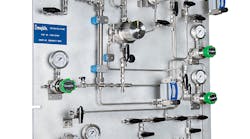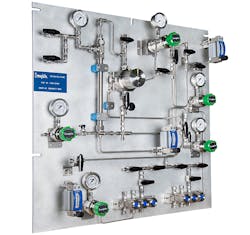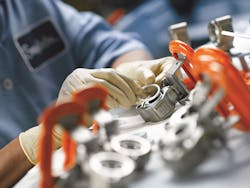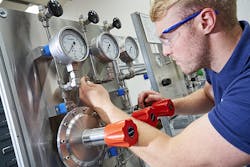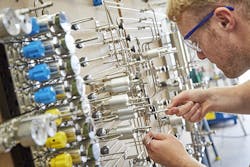How to use the STAMPED method to match the right valve to your system
Reliable industrial fluid and instrumentation system performance often depends on designing the system properly and selecting the right components. Depending on your application’s needs, the wrong design choice can lead to poorer performance, potential safety risks, and increased downtime required to resolve issues.
One component in particular can have a major influence on your overall system: Valves. Generally, a valve’s role in an industrial fluid system is to control flow to the operator’s desired levels. Valves are typically selected and incorporated into the system specification during the initial design stage (see Figure 1). Once the system is in service, maintenance technicians will typically replace a valve with the same type already found in the system.
Figure 1. Valves are a necessary component in a wide variety of industrial fluid system operations. Determining the right valve for your application can be accomplished by following the STAMPED method. All images © Swagelok
This makes it critically important that the proper valve – one that will deliver the necessary levels of performance and functionality – is chosen upfront. Total system design must be considered to ensure safe, trouble-free performance. Function, material compatibility, adequate ratings, proper installation, operation, and maintenance are the responsibilities of the system’s designer and user.
One method that can help guide you to the right choice is known as the STAMPED method, which accounts for Size, Temperature, Application, Media, Pressure, Ends (or fittings), and Delivery. By evaluating your system needs according to the STAMPED process, you will have a better understanding of which type of valve will best fulfill those needs during operation.
S: Size
A valve’s size is directly correlated with its maximum flow capacity. Choosing the appropriate size is important to meet your system’s desired, or required, flow rate.
Typically, valve manufacturers will provide a flow coefficient (Cv) for their products. Cv is defined as the amount of water in U.S. gallons per minute that will flow through a valve with a 1 psi pressure drop across the valve at a temperature of 60°F (16°C). Cv indicates the relationship between pressure drop across the valve and the corresponding flow rate. Calculating and using Cv to predict flow is more complex with compressible fluids, such as gases, but it still provides a good method for sizing valves in most applications.
Together with the valve’s size, the geometry of its flow path or orifice will also influence Cv and how a fluid moves through the valve. Orifices can vary considerably in different types of valves – generally, the larger the orifice, the greater the valve’s potential maximum flow capacity. Ball valves, for example, have large, open orifices and will provide minimal flow resistance when open. Needle valves, by contrast, have narrower flow paths with gradual shut-off that can help restrict or slow down flow. Consider these kinds of functional differences and correlate them with the intended function of your application when making your selection.
When in doubt, your valve manufacturer should be able to aid in sizing the valve for your application. Some manufacturers offer useful tools, like an online Cv calculator, that can be used as a good starting point during the selection process.
T: Temperature
Temperature can have a significant influence over your valve selection. Both the internal operating temperature of your fluid as well as environmental ambient temperatures where the system will be functioning should be considered. Will these temperatures be constant (i.e., if your system is operating in a climate-controlled building) or will they naturally fluctuate (i.e., if your system is operating outdoors)?
Temperature conditions may affect your valve selection or how frequently you will need to perform preventive maintenance. For example, extreme temperature fluctuations may cause your valve’s sealing materials to expand and contract. Additionally, metallic components may lose strength when subjected to high temperatures, contributing to reduced pressure ratings. For these reasons, it is important to ensure that the valves you select feature robust, highly-rated materials of construction (see Figure 2).
Figure 2. Valves contend with a broad range of operational conditions, and it is important that your selection is made with the right materials of construction. All images © Swagelok
To ensure performance at your desired operational temperatures, check with your manufacturer to confirm the valves have been fully tested at temperature extremes that can be common in industrial fluid system applications.
A: Application
Think about your application and what kind of functionality you need your valve to provide. Do you need to start and stop fluid flow quickly? Do you need to control the direction of flow? Regulate flow levels? Protect your system from overpressure?
A thorough evaluation of these questions will help guide a sound valve choice. Comparing a simple two-way ball valve and a needle valve provides another good example for selection. While some manufacturers may advertise ball valves as able to provide throttling functionality, this type of valve does not offer high levels of throttling performance. By design, ball valves are meant to be used in the fully open or the fully closed position.
A better option for throttling or regulating flow would be a valve designed for such purposes. Needle valves can provide reliable and consistent flow control and will offer leak-tight shut-off when necessary. If your needs are more precise – in an analytical application, perhaps – a metering valve can provide even finer, more precise adjustments based on your needs.
M: Media
Your process fluid itself also has some implications around valve choice, particularly when it comes to material composition.
For example, it is critical to make sure the system media is chemically compatible with the materials that will make up your valve bodies, seats, stem tips, and other elements. Unwanted interactions between an incompatible fluid and your valves can lead to corrosion, embrittlement, or stress corrosion cracking. These are serious issues that can lead to valve failure, and the resulting safety and operational concerns in your facility.
Like temperature, it is not just internal compatibility you should consider. Will your valves be operating in an area where they will be exposed to sunlight, rain, snow, frost, or ice? Will they operate in a marine environment, where chloride exposure can compromise integrity? Consider each of these variables when selecting valves to ensure optimized longevity and functionality.
P: Pressure
Pressure is another critical factor that will help you determine the best valve for your application. When considering pressure, it is important to distinguish between both working pressure and design pressure.
Working pressure is the normal operating pressure in your system, while design pressure indicates the valve’s manufacturer-provided maximum pressure limit. This is key to remember when selecting your valve because, as noted earlier, the temperature of the process fluid has considerable impacts on component performance. Depending on those extremes, your valve may have a considerably lower working pressure once in operation than its rated design pressure. Generally, as the temperature of the process fluid increases, the working pressure rating will decrease (see Figure 3).
Figure 3. Your valve’s ability to deliver performance under the pressure demands of your system is one of the most important considerations to be made during the valve selection and specification process. All images © Swagelok
Once incorporated into your system, it is likely your valve will be required to hold pressure and operate under a wide range of temperatures and pressures. Its ability to do so depends on its design, material selection, and testing validation. Also, it is important to remember to never exceed the design pressure of any fluid system component, unless doing so is performed under highly controlled testing or laboratory conditions.
E: End Connections
Whether they are integral tube fittings, pipe threads, pipe flanges, welded ends, or something else, valves come with a variety of different end connections (see Figure 4). And though not always associated with a valve’s construction, specifying the right type of end connection can help maintain a reliable, leak-tight system.
When specifying end connections, make certain they are appropriate for your desired system pressure and temperature and that they are sized correctly. Additionally, the right end connection can help simplify installation when it comes time to commission your system.
D: Delivery
When you have considered all the above variables and have made your selection, consider the final criterion of the STAMPED method: Delivery.
On-time delivery and reliable supply from your valve manufacturer are important in keeping your fluid system efficient and functioning as intended. Are your suppliers able to provide the valves you need when you need them? Are they willing and able to work with you to assess your needs and determine the right solutions based on your operational goals?
Hopefully, the answer to these questions is yes. Valve selection is integral to designing safe, efficient fluid systems, and the right supplier can make that selection easier.
Joe Bush is senior product manager for Swagelok Company.
